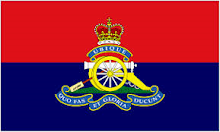 |
| Shoeburyness Gunner Park IJ |
The Royal Artillery has a long association with Shoeburyness, being a major location in the development of the guns that equipped the Royal Artillery.
In 1849 the Board of Ordnance purchased land at Shoeburyness for the purpose of the testing of artillery. The advancing development in the power and range of guns had rendered the previous ranges at Plumstead Common and Woolwich Common untenable.
The ordnance and ammunition for testing would be transported from Woolwich in barges.
Shoeburyness had an advantage of being an 'over the water' range where projectiles could be fired into water and later recovered at low tide.
The guns being tested in the 1850's were Smooth Bore Muzzle Loaders.
 |
| 1855 Shoeburyness Experimentation SBML |
The ranges were used during the summer until 1854 when a permanent station was established when Britain went to war in the Crimea, a conflict that lasted until 1856.
The years following the Crimea War would see significant change in the activities at Shoeburyness.
In 1858 William Armstrong had produced a Rifled Breach Loading gun at his Elswick Works in Newcastle. Trials and development of a revolutionary artillery equipment would follow.
 |
| 1858 Shoeburyness Armstrong RBL Guns |
A dedicated School of Gunnery was established in 1859 and the garrison expanded with the start of the construction of Horseshoe Barracks which was completed in 1862.
 |
| 1859 Shoeburyness Horseshoe Barrack |
Rising tensions in Europe with France and Austria going to war, together with French expansion of the port of Cherbourg raised concerns of French Invasion. A Volunteer Force was created with the formation of volunteer rifle corps and of artillery corps in defended coastal towns. The first volunteer artillery unit was formed in Tynemouth in August 1959.
In November 1859 the French launched the first ever ironclad warship La Gloire, challenging the Royal Navy's pre-eminence and threatening British interests. Experimentation began with new guns, rifled breach loading and rifled muzzle loaders.
 |
| Shoeburyness Artillery RML Experimentation |
In response to the launch of La Gloire, the British launched their first ever iron clad warship, HMS Warrior which came to into service in 1861. The development of heavier Armstrong rifle muzzle loading guns continued.
 |
| Shoeburyness Armstrong RML Guns experimentation |
 |
| Armstrong RML Guns experimentation |
To advance and promote the practice and science of artillery within the newly formed Corps of Artillery Volunteers, the National Artillery Association (NAA)was formed in 1863. To achieve those aims they began competitions between units began in 1865 on Shoeburyness ranges with the Queens Prize being the top prize.
 |
| Shoeburyness National Artillery Association Competition 1865 |
As well as the development and testing of armaments, experimental fortifications able to house the new types of guns being brought into service were constructed at Shoeburyness. Two experimental casemates were built between 1872 and 1873 to conduct experiments for coastal defence gun emplacements shooting through an embrasure. The guns used were a 12.5 inch 38 toon RML and a 12 inch 25 ton RML.
 |
| Shoeburyness Quick Firing Battery Experimental Casemate |
In 1877 a berth was built to facilitate the landing of rail mounted guns. It was named Gog's berth which came from the name of the two barges that used the berth, 'Magog' and 'Gog'
 |
| Shoeburyness Gogs Berth |
In January 1883 the London, Tilbury and Southend Railway began work to extend its line from London Fenchurch Street to Southend towards Shoeburyness.
Operations commenced in February 1884 and trains tracks where extended into the Shoeburyness Ranges. This allowed the movement of some guns and ammunition to the ranges by rail rather than barge.
 |
| Shoeburyness Military Railway |
The experimentation and trials were not without danger. In 1885 an explosion killed seven Royal Artillery personnel during experimentation with a new type of fuse.
Amongst those killed were Colonel Lyon, a member of the Ordnance Committee, Colonel Fox-Strangways, superintendent of the School of Gunnery, and Captain Goold Adams, assistant superintendent of the School of Gunnery.
 |
| Shoeburyness Explosion Casualties |
The use of Rifle Muzzle loading guns had predominated in the period from 1860 to 1880. The development of Rifled Breach Loading guns had continued and during the 1880's increased testing and experimentation of their use was undertaken at Shoeburyness.
 |
| 1880 Shoeburyness Breach Loading Guns trials |
The ever increasing size of guns still required the use of barges for the movement of some ordnance.
 |
| 1888 Shoeburyness BL16.25 inch naval gun landed by barge |
The continuing artillery development with ever increasing range and power necessitated the purchase of additional land. In 1889 the 'new ranges' to the North East of Shoeburyness came into use for experimentation and testing, with the original 'old ranges' being used as a training area.
A Heavy Quick Firing Battery was constructed in 1899-1900 for coastal artillery training. Two 6 inch and two 4.7 inch quick firing guns were mounted on it's roof
 |
| 1899 Shoeburyness Heavy Quick Firing Battery |
The experimentation and trials activity on the Shoeburyness Ranges had been conducted under the command of the School of Gunnery. In 1905 the Experimental Branch of the school became an independent operation which would be renamed 1920 as the Experimental Establishment.
In 1908 The Territorial Force was formed absorbing the Volunteer Artillery units bringing at end to the the National Artillery Competitions at Shoeburyness.
An iconic gun that was tested at Shoeburyness was the prototype 9.2 inch howitzer 'Mother' which would come into service in 1914 at the beginning of the First World War.
 |
| Shoeburyness prototype 9.2 inch howitzer 'Mother' |
During the First World War from 1914 to 1918, Shoeburyness continued as a training establishment , though there were changes to the functions it carried out.
Field Artillery and Horse Artillery instruction moved to Larkhill which would become the Royal School of Artillery. In 1915 the Anti-Aircraft School of Instruction was formed at Shoeburyness.
 |
| 1915 Shoeburyness Anti-Air Craft School |
On 6th April 1916 King George V visited the Old and New Ranges.
 |
| Shoeburyness visit of King George V April 1916 |
The British War Dog School was established Shoeburyness in 1917 to train dogs to carry messages to and from the front line.
 |
| Shoeburyness 1917 War Dog School |
After World War One development and trialling of weapons continued. This included guns that would come into service and used by Northern Gunners during World War Two and beyond; 25 pounder, 3.7 inch anti-aircraft gun and the 5.5 inch gun.
During World War Two some defensive capability was added with the construction of searchlights and gun emplacements. The primary roles of Shoeburyness as a training range and proofing / experimentation continued.
 |
| Shoeburyness 1939 2-pdr anti-tank guns at Gunnery school |
 |
| Shoeburyness 1940 Training artillery officers on coastal guns |
 |
| 1940 Shoeburyness Churchill Visit experimentations |
 |
| 1943 Experimental Establishment Shoeburyness |
 |
| Shoeburyness 1943 ATS Gunners firing 25 pounders |
In March 1943 Shoeburyness would become the headquarters of 5 Maritime Regiment Royal Artillery when the number of the RAA maritime units increased. The Maritime Regiments provided guns to defend merchant ships.
In the 1948 the Experimental Establishment became the Proof and Experimental Establishment (P&EE).
From 1968 to 1971 Shoeburyness was the home of 36 Heavy Air Defence Regiment Royal Artillery which was equipped with Thunderbird surface to air missile.
 |
| 1961 Shoeburyness Thunderbird 36 HAD Regiment |
The use of Shoeburyness for training and as a garrison declined from the 1960’s as the Army reduced in size. The garrison closed in 1976. The Old Ranges remained in use until 1998 when the land together with the garrison buildings were sold for residential development.
The proofing and experimentation continued on the New Ranges, though the military staff were reduced and the functions were taken on by civilian contractors, the last soldiers leaving in 1987.
MOD Shoeburyness is now managed by the defence contractor QinteiQ with 21 firing points for ordnance, munitions and explosives testing
 |
| Shoeburyness 105mm Light Gun |
.





































































